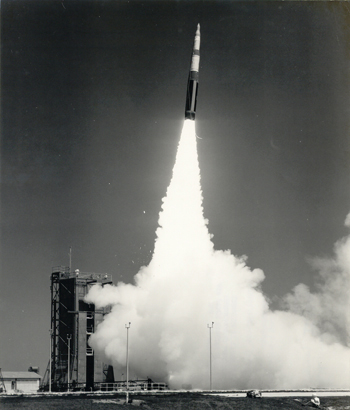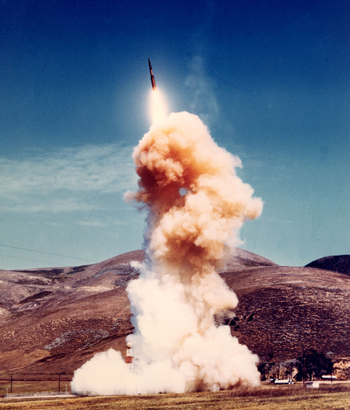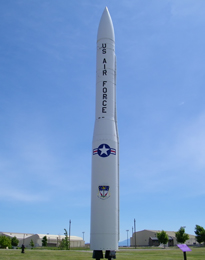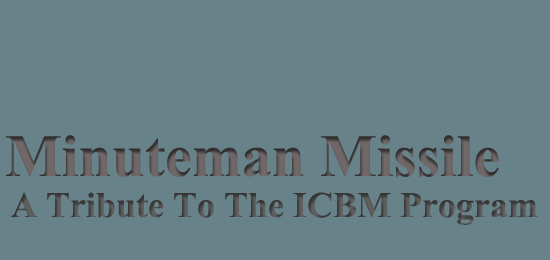
Minuteman II Test Launch

Minuteman II Launch
Minuteman II Missile
The Minuteman II, LGM-30F missile, had a number of significant improvements over the Minuteman I. The LGM-30F was a foot and a half taller. It weighed 73,000 pounds versus the 65,000 pounds of the LGM-30A/B. The Minuteman II also had an increased range to 7000 miles, compared to the 6300 miles of the Minuteman I. Additional improvements included an advanced guidance system, increased capability to survive the effects of a nuclear blast, and having a greater payload capacity.
The new LGM-30F was designed with a new second stage motor that incorporated a single nozzle and a secondary liquid injection for thrust vector control, which increased the range of the Minuteman II. These improvements also allowed the missile to carry the larger Avco W56 warhead, with a yield of 1.2 megatons.
The new guidance system made the LGM-30F more accurate, as well as allowing it to store more preprogrammed targets, a total of eight, into its internal memory. The Minuteman II also carried penetration aids that helped camouflage the warhead during its reentry. The first launch of this missile occurred successfully on September 24, 1964, and its first silo launch took place August 18, 1965.
The continued success of the Minuteman missile program, bolstered by the significant improvements in the Minuteman II missile, prompted the Secretary of Defense, Robert McNamara, to approve the Minuteman Force Modernization Program on November 8, 1963. This project outlined the eventual replacement of the entire force of deployed Minuteman I missiles, 150 LGM-30A models and the 650 LGM-30B missiles, with the Minuteman II missile.
The deployment of the Minuteman II consisted of two phases. The first phase began with deployment of the missile in recently constructed launch facilities at Grand Forks Air Force Base, North Dakota, and the 20th and last Minuteman squadron, the 564th Strategic Missile Squadron, at Malmstrom Air Force Base in Montana.
The first Minuteman II LGM-30F missile arrived at Grand Forks AFB August 5, 1965 and was emplaced into its silo two days later. The first flight of 10 missiles became operational at Grand Forks AFB October 31, 1965, the first squadron (50 Minuteman IIs) occurred April 25, 1966, and the first wing was finalized at Grand Forks December 7, 1966.
The first phase of deploying the Minuteman II missile was complete when the Air Force emplaced the 1000th Minuteman missile at the new 564th SMS at Malmstrom Air Force Base in Montana on April 21, 1967. In reaching this milestone, the Air Force was standing tall with a deployment of 800 Minuteman I missiles, and 200 Minuteman II missiles, all on operational alert. In retrospect, the Air Force had placed on operational alert its first flight (10) of Minuteman LGM-30A missiles at the 10th Missile Squadron at Malmstrom AFB, dating October 22, 1962. Four years and six months later, the Air Force had a total of 1000 Minuteman missiles that it was overseeing.
The depth and magnitude of what transpired to make the Minuteman missile program a reality, is astounding. To this day, a significant number of people are unaware of what actually took place in the research that occurred, the designing, the building, the trouble shooting and fine tuning that made these 1000 Minuteman missiles operational, ready to launch at a moments notice. The United States Air Force has been proud of this accomplishment since the early sixties, and rightfully so.
Phase two of the Air Force's deployment strategy, also known as the Minuteman Force Modernization Program, consisted of replacing the Malmstrom AFB Minuteman I LGM-30As, and the Whiteman AFB Minuteman I LGM-30Bs with the new Minuteman II LGM-30Fs. This program required the complete retrofitting of each launch facility (missile silo) and launch control center at Malmstrom and Whiteman. The retrofitting task started at Whiteman Air Force in Missouri, May 7, 1966. After completing the wing at Whiteman on October 3, 1967, work began on retrofitting Malmstrom AFB's 150 LGM-30As, with the first squadron being finalized December 12, 1967. The complete task of retrofitting the Minuteman I facilities, preparing them for the Minuteman II at Malmstrom was finalized July 2, 1969.
One struggle the Air Force was experiencing in preparing to deploy the LGM-30F was its new guidance system. Initially a number of problems came to the forefront regarding the new micro-circuity used in the system. The Mean Time Between Failure, MTBF, for the LGM-30F was in the hundreds of hours. With the older Minuteman I system, it had a MTBF of approximately 5000 hours. The Autonetics Division at Rockwell, which held the contract for the guidance system, struggled in manufacturing enough units to not only equip the new Minuteman II missile, but to replace the newer guidance systems that had already failed. In putting forth a diligent effort to remedy the problem, the Autonetics Division solved the problem and the guidance system has established a strong record for reliability.
As the Air Force was working with Autonetics to address the guidance system issues, they also began to address the doubts that were circulating regarding the ability of the Minuteman missiles to respond to a legitimate launch order. During the mid sixties, a program was developed to prove that the Minuteman could in fact be successfully launched from a operational silo. The project created was called Long Life, and the first launch on March 1, 1965 proved to be successful with the launching of a Minuteman LGM-30B missile. The launch occurred at an operational Launch Facility at Ellsworth Air Force Base. The year following, on October 19, and again on October 26, 1966, two attempts to launch a Minuteman II missile were not successful. A second program called Giant Boost was developed to test the Minuteman two years later, and on August 14, 1968 a third missile was not successful in their attempts to launch it.
Minuteman II Missile - Additional Information
Once the Minuteman II LGM-30F missile had been placed on operational status, the Air Force also utilized the LGM-30F as a launch vehicle for the ERCS program, Emergency Rocket Communication Satellites. The ERCS consisted of a UHF transmitter with a prerecorded message, that once launched, this allowed the military to transmit important messages and/or commands to any unit that was in the line of sight of the rocket. The first Minuteman II that was equipped with the ERCS system was test launched on April 17, 1967. This system became operational at the 351st Strategic Missile Wing at Whiteman Air Force Base October 10, 1967.

